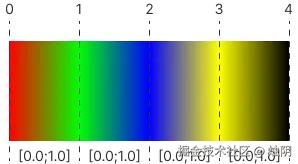Task
Create a shader program that generates a gradient image using an array of 5 colors. The colors are defined in the following array:
scss
vec3 palette[5] = vec3[5]
(
vec3(1.0, 0.0, 0.0),
vec3(0.0, 1.0, 0.0),
vec3(0.0, 0.0, 1.0),
vec3(1.0, 1.0, 0.0),
vec3(0.0, 0.0, 0.0)
);The program should determine which color range the current pixel falls within and interpolate its color accordingly. This will result in a smooth gradient transition between the colors in the array.

根据
palette提供的数组创建一个阶梯状的渐变颜色。每两个颜色之间使用线性插值的方式。
Theory
函数介绍
1. floor(x) - 数学函数
- 定义 :它返回不大于
x的最大整数。 - 举例 :
floor(3.9)->3.0floor(3.1)->3.0floor(-3.9)->-4.0(因为-4是小于-3.9的最大整数)
- 返回类型 :
float。
2. int(x) - 类型转换函数
- 定义:将一个浮点数转换为一个整数,丢掉小数部分。
- 举例 :
int(3.9)->3int(3.1)->3int(-3.9)->-3(直接砍掉.9)
- 返回类型 :
int。
任务解析
创建5级阶梯:
使用 floor():
glsl
float steps = 5.0;
float value = floor(uv.x * steps) / steps; // 结果是 {0.0, 0.2, 0.4, 0.6, 0.8}
// float value = float(int(uv.x * steps)) / steps; 或者使用int
gl_FragColor = vec4(vec3(value), 1.0); 这样就会产生从黑到灰的5级阶梯。
Answer
glsl
uniform vec2 iResolution;
vec3 palette[5] = vec3[5] (
vec3(1.0, 0.0, 0.0),
vec3(0.0, 1.0, 0.0),
vec3(0.0, 0.0, 1.0),
vec3(1.0, 1.0, 0.0),
vec3(0.0, 0.0, 0.0)
);
void main() {
vec2 uv = gl_FragCoord.xy / iResolution.xy;
float steps = 5.0;
int index = int(uv.x * (steps - 1.0)); // 数组序号最大为4.0
//float value = floor(uv.x * steps) / steps; // 结果是 {0.0, 0.2, 0.4, 0.6, 0.8}
vec3 color = mix(palette[index], palette[index + 1], fract(uv.x * (steps - 1.0)));
gl_FragColor = vec4(color, 1.0);
}效果

练习
最后
如果你觉得这篇文章有用,记得点赞、关注、收藏,学Shader更轻松!!